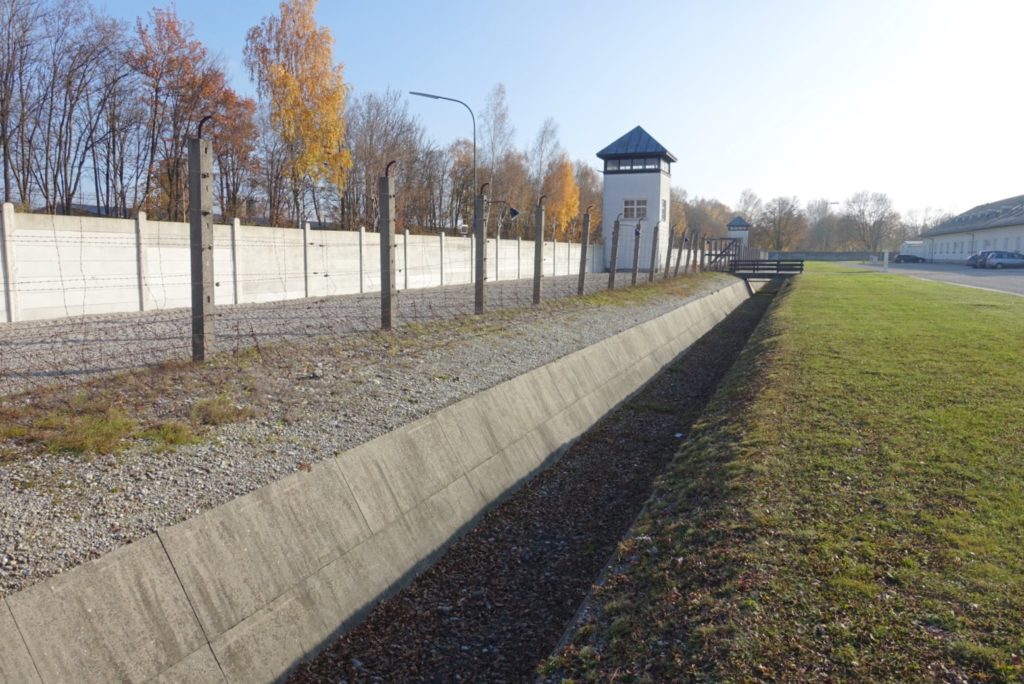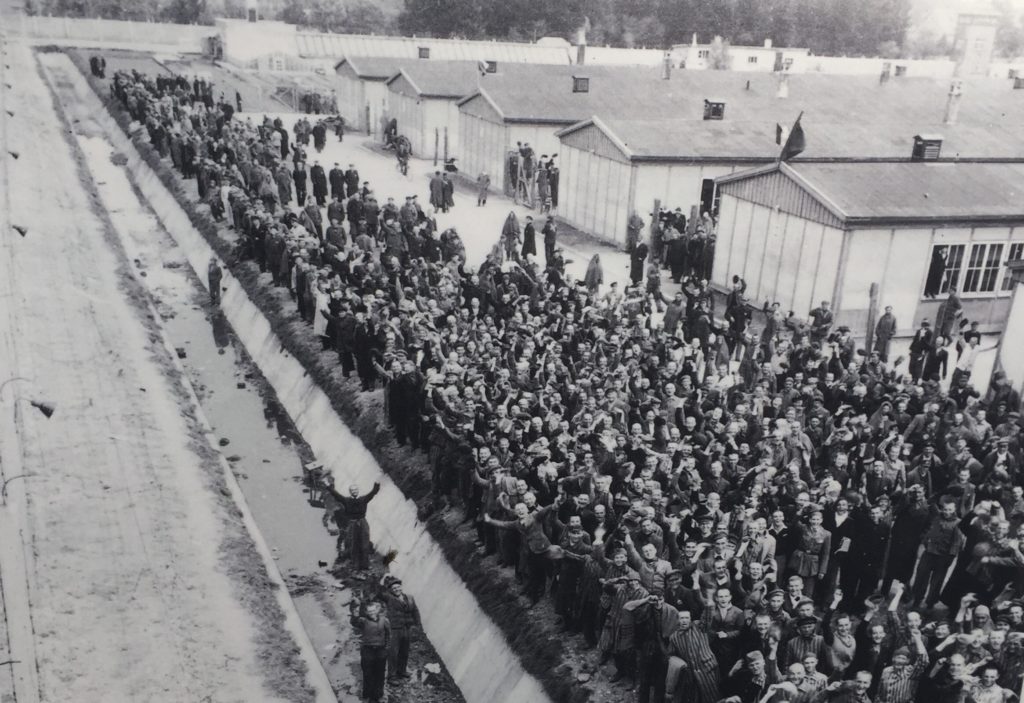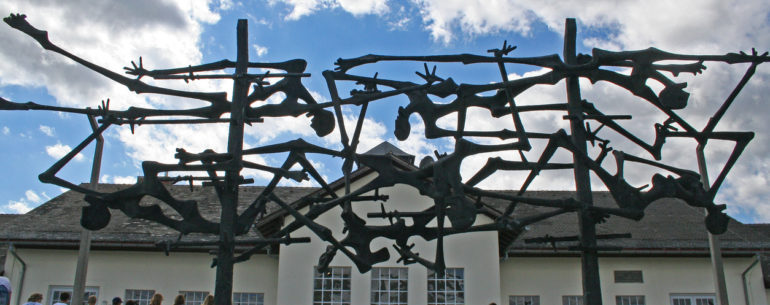An encounter with what Carl Jung called The Shadow is to confront the reality that everything horrible that human beings have done, was done by human beings, and that you are one of them.
Man Overseas Travel’s trip to Dachau Concentration Camp last week marked my third different concentration camp visit in four years— my first in Germany. Dachau is a 25-minute train ride from Munich, then a ten-minute shuttle bus to the concentration camp.
On March 22, 1933, just two weeks after Adolf Hitler was appointed Reich Chancellor, the first concentration camp was set up in Dachau, a town in Upper Bavaria.
Dachau (1933-1945) became a “school of violence” for the SS under the command of Reichsführer-SS Heinrich Himmler. He began incarcerating all political opponents of the Third Reich: lawyers, homosexuals, gypsies, handicapped, Catholic priests, and the Jewish population.
The camp served as the prototype for subsequent concentration camps built by the National Socialist (Nazi) government. Its basic organization, plans for buildings and camp layout were applied to all later camps.
Camp Labor
Prisoners were forced laborers at Dachau. They worked on construction projects, built roads, worked in gravel pits, and drained marshes.
Once World War II started, prisoners became an important component of German armament production. Many of the subcamps were built near armament factories throughout southern Germany. Thousands of prisoners were worked to death.
There were 32 barracks constructed at Dachau. One barrack was reserved for clergy who opposed the Nazi regime; another was used for medical experiments.
Nazi Medical Experiments
In one type of medical experiment, there were almost 400 hypothermia experiments conducted on roughly 300 inmates between August 1942 and May 1943. They’d be immersed in ice water to see how long the human body could survive in freezing temperatures. If the prisoner survived, he’d be subjected to “rewarming,” often by being immersed in boiling water. Based on testimony of medical assistants at Dachau, only two prisoners subjected to hypothermia survived the war, both of whom became “mental cases.”
Gruesome tests were done to see if excessive bleeding could be halted.
Nazis also conducted altitude sickness experiments using a decompression chamber. This was done to determine the maximum altitude that fighter pilots and crews could parachute to safety from damaged aircraft.
There were new drugs tested by giving prisoners diseases. Some were put in glass cages while mosquitoes infected them with malaria; others were given Tuberculosis.
End of Misery
In twelve years of the camp’s existence, over 200,000 persons from throughout Europe were imprisoned at Dachau and its 140 subcamps. All were persecuted for political, biological, and racist ‘reasons.’ About every fifth prisoner died.
Dachau had two sections—the camp and the crematoria area. Seven guard towers were situated just beyond electrified barbed-wire fencing. Inside the fences were large ditches. Prisoners would be shot if caught in a ditch; many entered voluntarily to end their misery.

The 20th Armored Division and 42nd Rainbow Division of the U.S. 7th Army liberated Dachau on April 29, 1945. Barbarism at the first Nazi Concentration Camp was over.

Dachau is now a cemetery, memorial, museum, and place for learning.
Everyone I’ve taken to tour a Nazi Concentration Camp has been moved by the experience. Days spent there are impactful in ways I sometimes have trouble finding words to describe.
You can’t walk through a former gas chamber where the greatest atrocities in the history of humanity occurred and not be changed a little. It’s where prisoners were told to undress for a shower, but the shower-heads were fake. A cyanide-based poison (Zyklon B) was poured into the room by a masked man on the roof. Panic would ensue as everyone gasped for air, then tried to climb on top of each other to reach the only vent. But there was no way out. Prisoners were dead in less than 15 minutes. Bodies were picked apart to be sent to the crematoria, where they would be turned to ash.
Man’s Dark Side
“It’s the possibility of darkness that makes the day seem so bright.” – Stephen King
It’s a shock to the conscience to realize the Holocaust was perpetrated by human beings, who designed a very efficient, very effective, and very cheap way to kill millions of people.
A visit to a concentration camp forces you to confront man’s darker side. Carl Jung believed “The Shadow” resides in all of us, operating unconsciously; it thickens once we accumulate inevitable hurts and resentments.
We naturally think the darker qualities of humans don’t reside in us. It’s the other guy who is greedy, narcissistic, irrational or envious; yet, if a man can find no fault in himself, he lacks self-knowledge. Socrates’ “The unexamined life is not worth living” is merely an expansion on an aphorism from Ancient Greek: “Know thyself.”
Facing the Monster
I am no man; I am dynamite. – Friedrich Nietzsche
Part of growing up is moving beyond our fear of darkness. We stop using night lights because there are no monsters under the bed. As adults, we must reckon with the fact that real monsters are internal.
Much of the study of psychology has involved efforts to understand the nature of evil. We’re fascinated by serial killers and murderous dictators, who at times seem more human than monster. For example, Hitler doted on his dog; Heinrich Himmler wrote loving letters to his wife and daughter.
Walter Mattner, a police secretary from Vienna in October 1941, took part in the shooting deaths of 2,273 Jews in Belarus. He wrote to his wife, “My hand was shaking a bit with the first cars. By the tenth car, I was aiming calmly and shooting dependably at the many women, children and babies. Bearing in mind that I have two babies at home, I knew that they would suffer exactly the same treatment, if not ten times as bad, at the hands of these hordes.”
After World War II, it was believed such heinous acts could only have been committed by sadists and psychopaths, under orders from Hitler or Himmler. It was a view that was self-soothing, because it excused ordinary people who committed mass murder. Except Americans conducted surveys in occupation zones in October 1945 and found that twenty percent of people “agreed with Hitler’s treatment of the Jews.” Another nineteen percent said that although they thought Hitler’s policies toward Jews were harsh, they were fundamentally correct.
Murderers included Catholics and Protestants, old and young, people with doctorate degrees and poorly educated working-class folks. An estimated 200,000 persons from Germany and Austria committed murder between 1941-1945, and the number of psychopaths per capita wasn’t higher than normal.
Are You a Monster?
Jung believed the sooner one realizes his capacity for evil, the greater his possibility to do great good. It seems counterintuitive that one would need to face the bad as a precondition for the good, but it’s a notion that has been echoed by other prominent psychologists.
Have you ever been on a hike with someone and had the urge to push them off a cliff just because you could?
Have you ever noticed the lack of railing in a subway and thought I could push that guy in front of a train and end his life?
If by now you’re wondering if you are a “psycho” because you’ve had those thoughts, you can exhale. It only means that you’ve experienced what psychologists call The Imp of the Perverse, which is the urge to do the worst possible thing in a given situation simply because you can. The good news is that those who experience “the imp” are much less likely to commit such a tragedy.
The Masks We Wear in Public
It’s the man who doesn’t recognize his capacity for malevolence who is most inclined toward doing awful things.
Man’s lower nature is frequently disguised by his good intentions. He’ll make a show of being progressive and virtuous. He’s adamant that something must be done about the natural inequality of men; yet, is ignorant to the fact that most harm done to human beings in the last century was thanks to “do-gooders” like himself trying to “improve the world.” That he could improve the world by improving himself is either too simplistic or doesn’t occur to him.
“They don’t mean to do harm — but the harm does not interest them. Or they do not see it, or they justify it because they are absorbed in the endless struggle to think well of themselves.” – T.S. Eliot
Furthermore, he believes himself to be a good person solely for his opinions; thus, others must be bad people for theirs. He’s achieved modern-elitist culture’s trifecta: he’s smarter, more open-minded and more compassionate than you. If you doubt the former, just ask him; if you doubt the latter, notice how easily offended he gets on behalf of others.
A Vehement Anti-Racist
Taking offense on behalf of others is prevalent in our society. The act of doing so can be extremely gratifying to one’s ego. It gives the appearance of selflessness, while conferring moral respectability on one’s desire to despise others. But compassion is frequently threaded with envy; hate isn’t located far from the heart.
While virtue signaling is harmless on its face, be mindful that those who are easily offended are also easily persuaded. What happens when naïve do-gooders are given the opportunity to eliminate the supposed cause of their outrage? In our hyperbolic times, there’s no racist like a vehement anti-racist.
My biggest takeaway from my concentration camp visits is how dangerous it is to allow the scapegoating of a segment of the population for society’s ills, as Jews were in Germany. It’s something to consider as it becomes more and more acceptable for elites and their useful idiots to rail against a minority group, white males, or “the 1%.”




Thank you for writing this, Brad. As time passes, we often forget the atrocities that were committed by man against others. It is hard to comprehend how so many people could have been complicit in these evil acts and how they justified their actions.
Indeed. Thanks Kyle, I wrote it because I felt like it needed to exist.
Dachau is a sombering place to visit. I walked it in April and tried to imagine walking in a prisoner’s shoes. It’s heart wrenching and stomach turning.
It doesn’t take long for the weed of hate to sprout in our hearts and spread to others. We have to constantly be vigilant to chop it when it rears it’s ugly head.
As always, you’ve written a great blog. Enjoy your trip! I hope to go to Neuschwanstein Castle next time we go to Germany. We missed it last April because we got caught in a bad traffic jam on our way to Dachau and ended up having to stay overnight in Dachau.
Thank you, Alison. And thanks for sharing your experience visiting Dachau.
Neuschwanstein Castle is probably the most beautiful castle in the world – hope you get there soon!
Yet another really great blog. I’m going to share this on my Facebook page! This blog made me squeamish because I have chosen over the years to “out of site out of mind” react to the horrible tragedies that have happened at the camps. It’s chicken S, and I know that. So, today I read your article and also read more information about what happened at the concentration camps. I plan to visit one day to “feel the experience” and say a ton of prayers for all the families, and pay massive respect to all who endured this monster. Today, there will be ZERO complaining about anything from my end. And, I’m going to make an effort to be overly kind! Thank you sir! Enjoy your trips!
Love hearing that! Truly hope everyone gets the chance to visit a concentration camp someday. Have a great day, Mrs. Towns! 🙂
Great Reading
Thank you